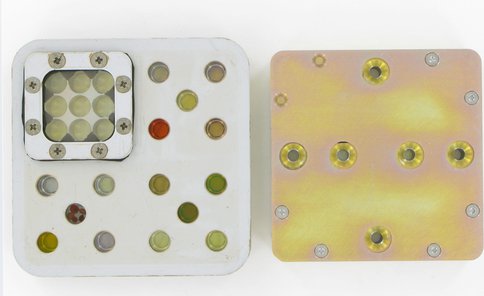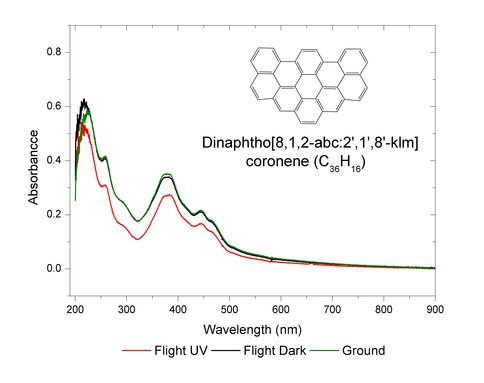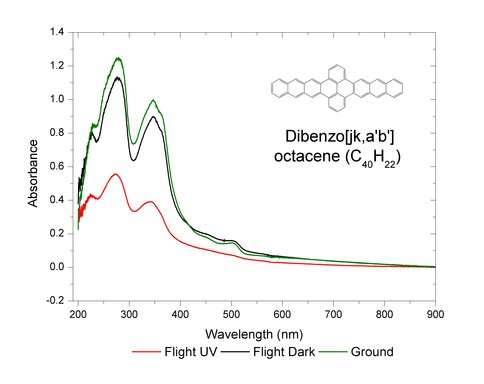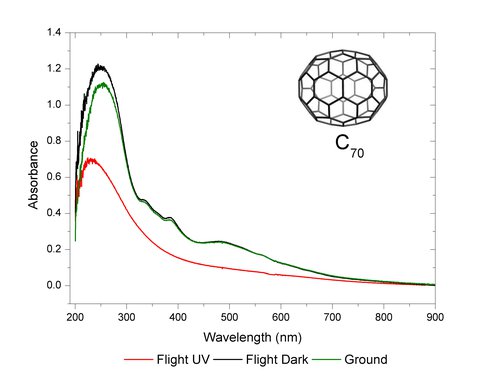2012 Annual Science Report
 University of Wisconsin
Reporting | SEP 2011 – AUG 2012
University of Wisconsin
Reporting | SEP 2011 – AUG 2012
Project 1E: The ORGANIC Experiment on EXPOSE-R: Space Exposure on the International Space Station ISS
Project Summary
In March of 2009, the Organic experiment integrated into the European multi-user facility EXPOSE-R, containing experiments dedicated to Astrobiology, was mounted through Extra Vehicular Activity (EVA) externally on the International Space Station (ISS). The experiment exposed organic samples of astronomical interest for a duration of 97 weeks (~22 months) to the space environment. The samples that were returned to Earth in spring 2011, received a total UV radiation dose during their exposure including direct solar irradiation of >2500h (>42.1 kJ per sample, based on ASTM E-490 AM0 standard solar spectrum between 119 and 400 nm). The Organics experiment on EXPOSE-R exposed 11 polycyclic aromatic hydrocarbons (PAHs) and 3 fullerene molecules in the form of ultra-thin films to solar UV under vacuum or controlled atmosphere. Ground control experiments of EXPOSE-R were performed at the DLR MUSC Center. A large fraction of the 210 samples (flight, flight dark, ground dark control, and the simulated ground control) have been measured by UV and IR spectroscopy in the last view months. Preliminary data of returned flight samples are shown.
Project Progress
The Organic experiment integrated into the EXPOSE-R facility monitors survival, destruction and chemical modification of polycyclic aromatic hydrocarbons (PAHs) and fullerenes in space environment. PAHs are highly abundant and ubiquitous compounds in the interstellar medium. Fullerenes C60 and C70 have been confirmed in the hydrogen-poor planetary nebula Tc-1 and recently also in other sources, although their abundance is estimated to be much lower compared to PAHs. Monitoring the behavior of these molecules upon space exposure will allow us to determine constraints on the photochemistry of these compounds in space environments. Since PAHs and probably fullerenes are also present in meteorites, the obtained data are also relevant for the reconstruction of events on the young planets (Groen et al. 2012).
Samples were received in 2012 and inspected, see Figure 1. Apart from analyzing the returned samples, measurements have been performed by all EXPOSE-R investigators to understand possible contamination issues. Loss of transmission due to deposits on sample windows and brown deposits identified at some positions within the experiment trays are currently under investigation. Our group supports investigations by the European Space Agency in order to interpret scientific data correctly.
Transmission/absorption spectra were recorded by Dr. K. Bryson and compared to ground truth experiments. Figures 2 and 3 show the UV-Vis solid spectrum of dinaphtho[8,1,2-abc,2’,1’,8’-klm]coronene (C36H16) and dibenzo[jk,a’b’]octacene (C40H22) sealed in closed cells, respectively after exposure on the ISS. Both PAHs molecules have a very different geometry, pericondensed and catacondensed, respectively. Strong degradation can be observed for the less compact PAH dibenzo[jk,a’b’]octacene. Figure 4 shows the UV/VIS spectra of the fullerene C70 thin film deposited onto a MgF2 disk sealed into a closed cell. Clusters observed by microscopy in combination with broadened peaks of the UV exposed C70 film indicates re-crystallization of the compound.
The next analysis will require to open the closed samples carriers and measure both windows of the individual cells in order to understand possible recondensation processes during flight of the sample on the backside windows. IR and Raman spectroscopy as well as analytical measurements are scheduled for samples of all carriers that will provide a comprehensive analysis of ground and spaced-based data.
K.L. Bryson, Z. Peeters, F. Salama, B.H. Foing, P. Ehrenfreund, A.J. Ricco, W. Schmidt, M. Breitfellner, E. Jessberger, A. Bischoff, F. Robert (2011) “The ORGANIC Experiment on EXPOSE-R”, Advances in Space Research, 48(12), 1980-1996.
J. Groen, D. Deamer, A. Kros, P. Ehrenfreund (2012) “Polycyclic aromatic hydrocarbons as plausible prebiotic cholesterol analogues”, Origins of Life and Evolution of Biospheres 42, 295–306
Retrieval of the carriers was followed by macroscopic and microscopic inspection for transmission, color changes and gradients.
UV/VIS spectra of dinaphto[8,1,2-abc:2’,1’,8’-klm]coronene thin film deposited on a MgF2 disks sealed into a closed cell. Red: UV exposed sample after exposure on the ISS. Black: Dark sample after exposure on the ISS. Green: Ground sample stored in a dark desiccator for the duration of the mission.
UV/VIS spectra of dibenzo[jk,a’b’]octacene (C40H22) thin film deposited onto a MgF2 disk sealed in a closed cell. Red: UV exposed sample after exposure on the ISS. Black: Dark sample after exposure on the ISS. Green: Ground sample stored in a dark desiccator for the duration of the mission.
UV/VIS spectra of the fullerene C70 thin film deposited onto a MgF2 disk sealed into a closed cell. Red: UV exposed sample after exposure on the ISS. Black: Dark sample after exposure on the ISS. Green: Ground sample stored in a dark desiccator for the duration of the mission. Clusters observed in the sample by microscopy and the broadened peaks of the UV exposed C70 film indicates the sample may have experienced re-crystallization.
Publications
-
Bramall, N. E., Quinn, R., Mattioda, A., Bryson, K., Chittenden, J. D., Cook, A., … Hoffmann, S. V. (2012). The development of the Space Environment Viability of Organics (SEVO) experiment aboard the Organism/Organic Exposure to Orbital Stresses (O/OREOS) satellite. Planetary and Space Science, 60(1), 121–130. doi:10.1016/j.pss.2011.06.014
-
Bryson, K. L., Peeters, Z., Salama, F., Foing, B., Ehrenfreund, P., Ricco, A. J., … Robert, F. (2011). The ORGANIC experiment on EXPOSE-R on the ISS: Flight sample preparation and ground control spectroscopy. Advances in Space Research, 48(12), 1980–1996. doi:10.1016/j.asr.2011.07.017
-
De Vera, J-P., Boettger, U., Noetzel, R. d. l. T., Sánchez, F. J., Grunow, D., Schmitz, N., … Spohn, T. (2012). Supporting Mars exploration: BIOMEX in Low Earth Orbit and further astrobiological studies on the Moon using Raman and PanCam technology. Planetary and Space Science, 74(1), 103–110. doi:10.1016/j.pss.2012.06.010
-
Ehrenfreund, P. (2011). A Multiple-Choice Essay. Astrobiology, 11(8), 737–741. doi:10.1089/ast.2011.0697
-
Ehrenfreund, P., McKay, C., Rummel, J. D., Foing, B. H., Neal, C. R., Masson-Zwaan, T., … Race, M. (2012). Toward a global space exploration program: A stepping stone approach. Advances in Space Research, 49(1), 2–48. doi:10.1016/j.asr.2011.09.014
-
Groen, J., Deamer, D. W., Kros, A., & Ehrenfreund, P. (2012). Polycyclic Aromatic Hydrocarbons as Plausible Prebiotic Membrane Components. Orig Life Evol Biosph, 42(4), 295–306. doi:10.1007/s11084-012-9292-3
-
Mattioda, A., Cook, A., Ehrenfreund, P., Quinn, R., Ricco, A. J., Squires, D., … Young, A. (2012). The O/OREOS Mission: First Science Data from the Space Environment Viability of Organics (SEVO) Payload. Astrobiology, 12(9), 841–853. doi:10.1089/ast.2012.0861
-
Nicholson, W. L., Ricco, A. J., Agasid, E., Beasley, C., Diaz-Aguado, M., Ehrenfreund, P., … Young, A. (2011). The O/OREOS Mission: First Science Data from the Space Environment Survivability of Living Organisms (SESLO) Payload. Astrobiology, 11(10), 951–958. doi:10.1089/ast.2011.0714
-
Srama, R., Krüger, H., Yamaguchi, T., Stephan, T., Burchell, M., Kearsley, A. T., … Röser, H. P. (2012). SARIM PLUS—sample return of comet 67P/CG and of interstellar matter. Exp Astron, 33(2-3), 723–751. doi:10.1007/s10686-011-9285-7
-
Vos, D. A. I., Cox, N. L. J., Kaper, L., Spaans, M., & Ehrenfreund, P. (2011). Diffuse interstellar bands in Upper Scorpius: probing variations in the DIB spectrum due to changing environmental conditions. A&A, 533, A129. doi:10.1051/0004-6361/200809746
- Ehrenfreund, P. & Westall, F. (2011). Astrobiology. In: Beysens, D., Carotenuto, L., Van Loon, J.J.W.A. & Zell, M. (Eds.). Laboratory Science with Space Data. Berlin: Springer.
-
PROJECT INVESTIGATORS:
-
PROJECT MEMBERS:
Antonio Ricco
Collaborator
Farid Salama
Collaborator
Kathie Bryson
Postdoc
-
RELATED OBJECTIVES:
Objective 3.1
Sources of prebiotic materials and catalysts




